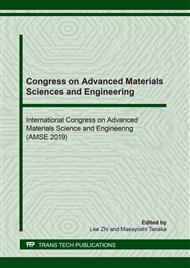p.70
p.79
p.84
p.90
p.99
p.105
p.110
p.116
p.125
Numerical Study of Fracture Behavior of Gradient Nano-Grained Metals by Molecular Dynamics Simulations
Abstract:
Benefit from the gradient distribution of microstructure, gradient nanograined (GNG) metals have broad application prospect owing to their advantages of both high strength and good tensile ductility. Meanwhile, the fracture behavior of gradient nanograined metals is different from that of traditional homogeneous materials. Using molecular dynamics (MD) method, we simulated the propagation of a crack in a pre-cracked GNG Cu. Voronoi method was adopted to generate the polycrystalline topology with gradient grain size, and FCC copper atoms were filled into the topological structure. The crack was introduced by removing three layers of atoms. Then, the MD specimen was loaded to simulate the crack growth and/or blunting. The micro-defects were identified by the common neighbor analysis parameter. The effects of the grain size gradient and the crack tip initial position on the crack growth were also investigated.
Info:
Periodical:
Pages:
99-104
Citation:
Online since:
May 2020
Authors:
Keywords:
Price:
Сopyright:
© 2020 Trans Tech Publications Ltd. All Rights Reserved
Share:
Citation:


